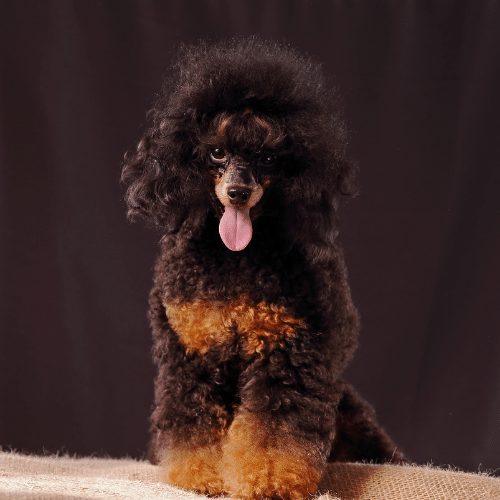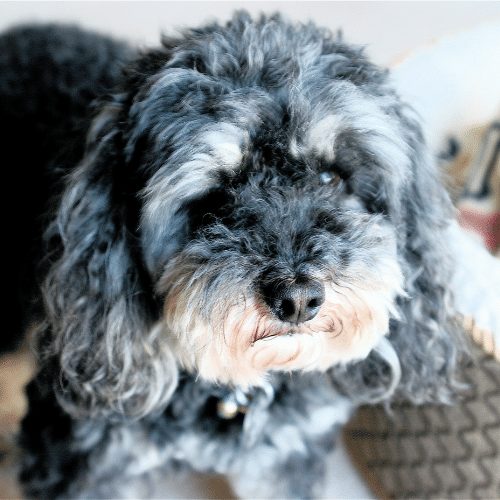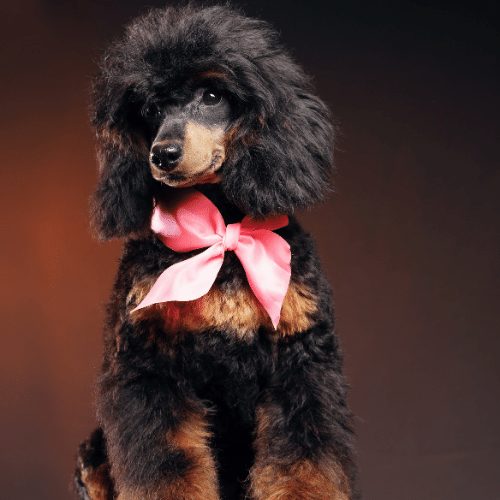Phantom Poodle
March 25, 2021 2022-03-10 9:32The Phantom Poodle is very special kind of dog, with the intelligence and exuberance of any Poodle and a little more besides.
When we think of a Poodle, we commonly picture a black, curly-coated, long-legged diva of a dog with a hairstyle to die for.
This is a bit of a restrictive stereotype given that Poodles come in 11 different solid colors and a variety of patterns, of which the Phantom Poodle is one.
Table of Contents

Appearance
Unlike the common-or-garden variety of Poodle, Phantom Poodles have a specific pattern imprinted onto their solid-colored coats.
Whereas a Parti Poodle’s coat is at least 50% white, a Phantom Poodle has a single-colored coat with bits of a secondary color appearing in specific places.
To be a real Phantom Poodle, a dog must have splashes of color in the following places:
- Above each of his eyes
- Along the sides of his muzzle
- Across his chest
- Along his legs
- Under his tail
In other words, he should look like some kind of crazy Doberman with a bouffant hairdo.
Fans of the Phantom refer to these splashes of color as Dobie markings because of their close resemblance to the standard black-with-brown-tips appearance of the Doberman.
Phantom Poodles have a much more varied color palette than the Doberman or the Rottweiler and Dachshund that also stick to the traditional black-and-brown combination. Phantom Poodles come in almost every color imaginable but can be broken down into four main categories:
- Black
- Chocolate – brown and apricot
- Red – red with apricot tips
- Silver – silver with cream markings
While the last three of these are very specific, black Phantoms can be almost any color combined with black. You could have a black Phantom with apricot tips or one with splashes of cream in all the right places. While Black Phantoms are, as their name suggests, primarily black, their markings can be almost any of the following shades:
- Apricot
- Brown
- Cream
- Gray
- Red
- Silver

Temperament
Poodles are, by and large, intelligent and elegant dogs. Athletic and easy to train, all sizes of Poodle excel at obedience, agility, and tracking events.
Despite their aristocratic appearance, Poodles are energetic, fun-loving animals who thrive on exercise and attention.
Although most people maintain that Phantom and Parti Poodles are no different from any other color Poodle, enthusiasts argue that “the character of the paretic colors was always unique… just that bit more clever, amusing, or intelligent than their solid-color littermates.”
Health
As with temperament, there is no real difference between a Phantom Poodle’s health status and that of a back or white Poodle. They have similar health concerns, like bloating, which sounds harmless but can be life-threatening, hip dysplasia, epilepsy, thyroid problems, and Addison’s disease, which affects the adrenal glands.
Unfortunately, as breeders attempt to fulfill the demand by breeding for specific colors or characteristics, so they have turned to inbreeding methods to produce these. This has resulted in a higher level of inbreeding that is desirable or sustainable.
Wright’s Coefficient of Inbreeding (COI) gives us the best estimate of just how inbred Poodles are, and the Standard Poodle, with a COI of around 18%, is most definitely inbred as any mammal with a COI of over 6% is inbred.
Like all Poodles, proper coat care is extremely important to prevent mats, dreadlocks, hot spots and skin infections. You should bathe your Phantom Poodle every month with a shampoo made specifically for Poodles and brush him daily. If you cannot manage the longer coat, keep him in a short cut.
Proper nutrition is very important. Feed your Poodle a high-quality dry, wet or raw food.
Where Did Phantom Poodles Come From?
Phantom Poodles didn’t emerge from the mists of time alone, and their origins are the same as any other type of Poodle.
Although often perceived as a French dog, the Poodle originated in Germany where it was known as the pudelin, which means “dripping wet.” Bred as a hunting dog, the Poodle was a water retriever, splashing through marshes, lakes, and ponds to recover ducks and other waterfowl.
It is because of these origins that the Poodle gained its remarkable hairstyles. Certain areas of the Poodle’s body were shaved to help protect his “vital organs and joints from the biting cold of constant water retrieval” and lessen the risk of his coat snagging on something underwater.
Even the classic Poodle topknot with its colorful bow comes from its sporting heritage. It is said to have been used to identify and locate the dog when working in the water.
As it was introduced to other parts of Europe, like France and England, the Poodle was given a new role – that of truffle hunter. Working alongside a Dachshund, the Poodle would seek out the valuable truffles that the Dachshund would then expertly evacuate.
Images from the 15th and 16th centuries show Parti Poodles in all their original glory, but few depict the Phantom Poodle. Why? Probably because the phantom pattern is a recessive trait that can remain hidden for several generations.
What Does It Take To Be a Phantom Poodle?
For a Poodle to have the Phantom coloration, it needs to have the ky/ky genotype. This is the collection of genes that allows colors other than black to manifest themselves.
The Phantom Poodle’s genetic makeup is similar to that of a Brindle Poodle that exhibits a tiger-stripe pattern on its coat although it’s also possible to get a Phantom Brindle Poodle which combines the Phantom markings with the Brindle’s stripes.
Breeding a Phantom Poodle to a solid-colored mate will mean the ky/ky genotype is passed on but, it doesn’t guarantee that the puppies will be Phantoms. In general, the solid color is more dominant, especially if that color’s black, so most of the first litter will probably lack the Phantom pattern.
If you breed one of the puppies from this first generation to another Phantom, because both parents carry the ky/ky genotype, chances are, the next generation will be predominantly Phantom.
Expert breeders have also noticed a correlation between specific colors and the Phantom Poodle appearance, with red, white, and silver Poodles more likely to develop the Phantom patterning than the black or brown.
Finding your puppy
The first step is tracking down a reputable breeder that has Phantom Poodle puppies available. This could take months, if not years, due to the relative scarcity of the pattern and the high demand.
Although some breeders specialize in producing Phantom puppies, the demand is so high, so you’ll probably need to join a lengthy waiting list before you can bring your perfect Poodle puppy home.
If you’re extremely lucky, you might find a Phantom Poodle at a poodle rescue center, but it’s a bit of a long shot.

How Much is a Phantom Poodle Puppy?
You might think that, as the American Kennel Club will not accept Phantom Poodles in the Conformation Ring, these dogs will be cheaper than their solid-colored siblings. Sadly, that’s not the case. The unusual coloring, and the complex genetics needed to produce it, set the standard and the price high for these dogs, with some Standard Phantom Poodle breeders charging upwards of $2,400 per puppy. Compare that to the average price for a solid-colored Poodle, and you’ll realize that two colors cost twice as much. You could pick up a solid-colored Standard Poodle for just $700 and a Miniature one for $1,000, but for a Phantom, you need a budget closer to $2,000 to $3,000, or even more for a top-quality dog.
How Long Does a Phantom Poodle Live?
Phantom Poodles can be expected to live as long as any other type of Poodle although, it should be noted that Standard Poodles have a slightly shorter life expectancy than either the Toy or Miniature versions.
While a Toy Phantom Poodle has an average life of around 14.5 years, a Miniature’s is slightly shorter at 14, and the Standard’s shorter again at 12.
Are Phantom Poodles Difficult to Train?
Like their solid-colored cousins, Phantom Poodles are eager to please and highly intelligent. This makes them keen students, although their instincts may sometimes get in the way. Having been bred as hunting dogs, Poodles have a naturally high prey drive and awareness of their environment, which means they need lots of stimulation and exercise.
Poodles are people-oriented dogs and, without enough human company, can develop unwanted and destructive behaviors. Poodles also become depressed if they don’t get enough attention and may also exhibit signs of separation anxiety when parted from their chosen human.
Early puppy training and regular exercise, along with stimulating games and proper socialization can help your Phantom Poodle adjust more readily to his environment and become a loyal and content companion.
Can You Show Phantom Poodles?
Currently, the American Kennel Club (AKC) only allows Phantom Poodles to compete in agility and obedience competitions, not conformation. The United Kennel Club (UKC), on the other hand, recognizes the Phantom Poodle as part of the multi-colored Poodle breed and will only disqualify a dog if it’s aggressive or extremely shy.
The Bottom Line
You don’t have to love ghost stories to fall in love with the striking patterns of the Phantom Poodle.
With the same friendly temperament and life expectancy as any other Poodle, the Phantom Poodle will slip into family life with comparative ease.
These energetic and intelligent dogs love human company, so aren’t suited to homes where the two-legged residents spend most of their time away.
If you want a Poodle that’s going to turn heads as well as keep you company on long walks, a Phantom Poodle is ideal, although, in my opinion, the Tuxedo Poodle is the most beguiling.
Phantom Poodles are largely healthy dogs, as long as you source your puppy from a reputable breeder. Inbreeding can negatively affect a dog’s health, so it’s worth investing the time and effort required to find a legitimate breeder, especially if you’re going to be spending $2,000 or more on your Phantom Poodle puppy.
Only get a Phantom Poodle if you’ve got the time and dedication to provide for all his needs, from grooming and exercise to training and companionship. If you can meet those, you’ll have yourself one of the most loyal and protective dogs you could imagine – and one that stands out from the crowd with his Phantom patterns.



